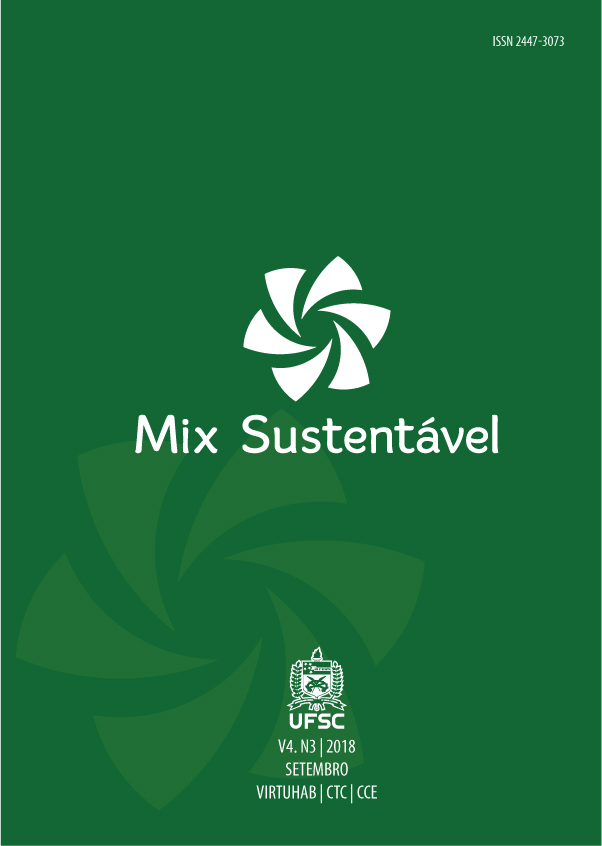CEMENT CONTENT REDUCTION IN CONCRETE THROUGH AGGREGATE OPTIMIZATION AND PACKING: A SUSTAINABLE PRACTICE FOR PAVEMENT AND SEAPORT CONSTRUCTION
DOI:
https://doi.org/10.29183/2447-3073.MIX2018.v4.n3.23-30Palavras-chave:
Aggregate optimization, Concrete, CO2, Infrastructure, SustainabilityResumo
Based on the full-bodied scientific consensus that climate warming is occurring on Earth, significant environmental and economic benefits may be obtained from cement content reduction in concrete, naming reduction in CO2 emissions, energy consumption, and construction costs. In contrast, standard limestone aggregate may experience increase in mining rate. The objective of this study was to propose the reduction of cement content in concrete framed by aggregate optimization as a viable alternative to reduce environmental effects from the cement industry. It was concluded that the higher the concrete volume in construction, the more environmental benefit can be obtained by reducing cement content in concrete. A 25 % cement reduction in a concrete pavement led to a decrease of 80.000 tons in CO2 emission, while a seaport construction displayed a decrease of 17.000 tons of CO2. The higher the designed cement per volume of concrete, the more budget savings in case of reduction in cement content. Port construction presented a reduction of 20,10 USD per m3 of concrete in cement costs against 11,04 USD per m3 in pavements. A 11,5 % increase in aggregate mining is expected when concrete contains less cement in its composition, targeting South Florida (U.S.A.) quarries.
Referências
NEW CLIMATE ECONOMY. The Global Commission on the Economy and Climate The Sustainable Infrastructure Imperative: Financing for Better Growth and Development. Washington, DC, USA, 2016.
KHATIBMASJEDI, S., DE CASO Y BASALO, F. J., AND NANNI, A. SEACON: Redefining Sustainable Concrete, Fourth International Conference on Sustainable Construction Materials and Technologies. Las Vegas, NV, USA, 2016.
MEHTA, P. K. Greening of the Concrete Industry for Sustainable Development. Concr. Int., vol. 24, no. 7, 2002, pp. 23–28.
AGOPYAN, V. AND JOHN, V. M. O desafio da sustentabilidade na construção civil. Sao Paulo: Blucher, 2011.
AISSOUN, B. M., HWANG, S.-D., AND KHAYAT, K. H. Influence of aggregate characteristics on workability of superworkable concrete. Mater. Struct., vol. 49, no. 1–2, 2016, pp. 597–609.
LATIN AMERICA CONSERVATION COUNCIL. Smart Infrastructure for Latin America. Arlington, VA, USA: The Nature Conservancy, 2015.
INTERNATIONAL ENERGY AGENCY. Energy Technology Perspectives: Scenarios & Strategies To 2050. Paris, FR, 2008.
MEHTA, P. K. AND MONTEIRO, P. J. M. Concrete: microstructure, properties, and materials. New York, NY, USA: Mc Graw Hill, 2006.
LINDQUIST, W., DARWIN, D., BROWNING, J., MCLEOD, H. A. K., YUAN, J., AND REYNOLDS, D. Implementation of concrete aggregate optimization. Constr. Build. Mater., vol. 74, 2015, pp. 49–56.
MOHAMMED, M. H., EMBORG, M., PUSCH, R., AND KNUTSSON, S. Packing Theory for Natural and Crushed Aggregate to Obtain the Best Mix of Aggregate: Research and Development. Proc. WASET Int. Conf. Civ. Constr. Eng. Stock. Sweden, 2012, vol. 6, no. 7, 2012, pp. 819–825.
MOINI, M., FLORES-VIVIAN, I., AMIRJANOV, A., AND SOBOLEV, K. The optimization of aggregate blends for sustainable low cement concrete. Constr. Build. Mater., vol. 93, 2015, pp. 627–634.
DE LARRARD, F. Concrete Mixture Proportioning: A Scientific Approach. Boca Raton, FL, USA: CRC Press,1999.
TASI, C. T., LI, L. S., AND HWANG, C. L. The Effect of Aggregate Gradation on Engineering Properties of High Performance Concrete. J. ASTM Int., vol. 3, no. 3, 2005, pp. 1–12.
RIFKIN, J. Entropy: into the greenhouse world. Madison, WI, USA: Bantam Books, 1989.
ASTM INTERNATIONAL. ASTM C33 / C33M-16e1: Standard Specification for Concrete Aggregates, ASTM International, West Conshohocken, PA, 2016.
ASTM INTERNATIONAL. ASTM C150 / C150M-17: Standard Specification for Portland Cement. West Conshohocken, PA, USA, 2017.
AMERICAN CONCRETE INSTITUTE. ACI 211.1: Standard Practice for Selecting Proportions for Normal, Heavyweight, and Mass Concrete. Farmington Hills, MI, USA,1991.
ANTUNES, RODRIGO, AND TIA, MANG. Influence of Intermediate-Sized Particle Content on Traditional Dry-Rodded and Vibrated Aggregate Packing. Int. J. Eng. Res. Appl, vol. 8, no. 4, 2018, pp. 21–27.
LARROSSA, M. C., REAL, M. V., AND DIAS, C. R. R. Análise estatística e teste de conformidade do concreto de obras portuárias. Rev. IBRACON Estruturas e Mater., vol. 7, no. 3, 2014, pp. 468–482.
Downloads
Publicado
Como Citar
Edição
Seção
Licença
Aviso de Direito Autoral Creative Commons
1. Política para Periódicos de Acesso Livre
Autores que publicam nesta revista concordam com os seguintes termos:
a. Autores mantém os direitos autorais e concedem à revista o direito de primeira publicação, com o trabalho simultaneamente licenciado sob a Licença Creative Commons Attribution que permite o compartilhamento do trabalho com reconhecimento da autoria e publicação inicial nesta revista.
b. Autores têm autorização para assumir contratos adicionais separadamente, para distribuição não-exclusiva da versão do trabalho publicada nesta revista (ex.: publicar em repositório institucional ou como capítulo de livro), com reconhecimento de autoria e publicação inicial nesta revista.
c. Autores têm permissão e são estimulados a publicar e distribuir seu trabalho online (ex.: em repositórios institucionais ou na sua página pessoal) a qualquer ponto após o processo editorial, já que isso pode gerar alterações produtivas, bem como aumentar o impacto e a citação do trabalho publicado (Veja O Efeito do Acesso Livre).




